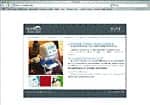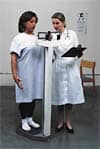
I am looking for information on whether it is acceptable to use gold cup electrodes for the EEG while using snap-on electrodes for the eyes and chin. Is this acceptable, or will it cause artifact in your study? Do you know of any information or where it can be found?
Murphy: The AASM Manual does not specify the type of electrodes that should be used nor does it recommend that all electrodes should be the same. However, this is discussed in the Fundamentals of EEG Technology, Volume 1: Basic Concepts and Methods by Tyner, Knott, and Mayer that talks about using similar metal when performing EEG studies. Mixing gold and silver/silver chloride electrodes is usually not a problem unless DC voltages are being measured. Many sleep labs mix gold cups with snap electrodes without the introduction of problematic artifact. Gold cups are not solid gold, according to this publication, but are silver coated with gold, and most snap electrodes are silver/silver chloride, so perhaps the metals are similar enough to reduce the likelihood of unwanted artifact.
Have the AASM standards changed the way the hookups are applied? For example, are the leg leads gold cup, along with the eyes and ground and chin? Or can they still be used with snap electrodes?
Murphy: There have been no changes in the AASM requirement for the type of electrode used as far as surface electrodes are concerned, and nothing stating that gold cups are required.
What signs do you look for to determine if an EEG or EMG lead needs to be replaced?
Murphy: The new AASM guidelines suggest that impedance levels for all electrodes should be less than 5K ohms. If you are experiencing 60Hz artifact, check your impedance. If you are experiencing popping artifact, check for adequate electrolyte and for a skin-tight connection. If your electrolyte is adequate, check the connection of the wire at the electrode as well as at the insertion into the connector and finally the connection to the headbox. Assuming the wire is not obviously frayed or broken and the connection points are all good, then replace the wire.
Do you have any tricks for applying and keeping the pressure flow transducer and ETCO2 cannula in place and secure on a pediatric patient less than 4 years old for the entire PSG?
Murphy: I asked our senior clinical educator for help on this one. Here is Belinda Gray’s advice.
Children 0-4 have varying coping strategies, but I will try to touch on a few suggestions that could be tried. First and foremost, it is important to make sure you use sensors appropriate for the age group you are dealing with.
For infants, small strips of tape can hold the cannula in place and socks on the hands might be helpful. If the child does not seem to tolerate the sensor while awake, it might be something that can be applied once the child falls asleep. Make sure you communicate to the family that you will be coming back in to apply some important sensors once the child falls asleep, and you might find the family member is willing to assist in making sure it stays on during the night.
For older toddlers, allowing the child to role play by applying sensors to a doll, to participate in the hookup, and to be involved in putting the sensors on might be helpful, or you could try desensitizing the patient by tickling the nose and the face around the nose with the cannula, but sometimes that plastic “moustache” is real annoying and again you might have better luck if you apply it once the child is asleep.
I score and have gotten several versions of “what is what” when it comes to the new rules for using a pflow and a thermistor. When scoring, if you have both sensors reading differently, one a hypopnea and the other saying obstructive, which one do you go with and why?
 |
Experts are available to answer your PSG, home testing, actigraphy, and oral appliance questions at Sleep Review’s Expert Insight |
Murphy: Thermal sensors utilize temperature differences to estimate airflow and are fairly reliable in detecting complete airflow cessation (apnea) but do not provide quantitative measures of airflow for hypopnea detection. If the thermal sensor (thermistor) and the pressure sensor (pflow) are reading differently, this is most likely due to sensor placement, how the patient is breathing, or an issue with the sensor. The patient could be mouth breathing, or one of the sensors could be dislodged. The AASM rules state that apnea events are scored from the thermal sensor and hypopneas are scored from the pressure sensor. If the thermal sensor is unreliable, then the pressure sensor can be used as an alternative sensor, and it would be important to determine the integrity of the signals produced when applying these rules.





